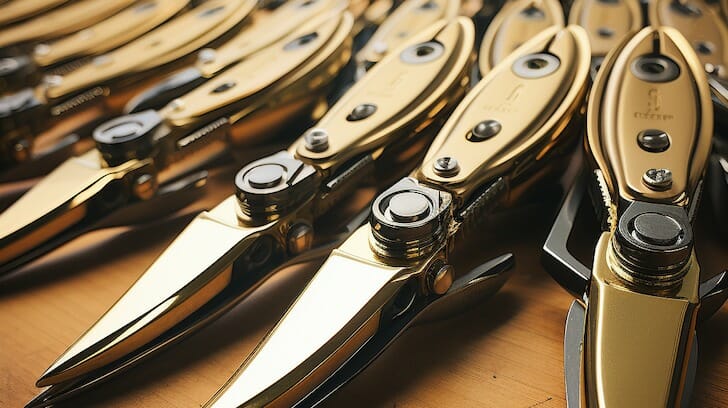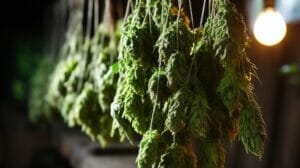Cure and Harvest Cannabis: Ultimate Guide | SeedsHereNow.com

Cure and Harvest Cannabis
Are you ready to unlock the full potential of your cannabis harvest? Well, look no further! Novice growers often overlook these two processes, but they hold the key to maximizing potency, flavor, and overall quality.
It’s all about removing excess moisture from those precious buds. Why is this important? Besides preventing mold from taking over your stash, proper drying is vital in preserving the valuable cannabinoids that give cannabis its magical effects. Nobody wants a weak buzz!
But wait, there’s more! Enter the curing process – a true game-changer for any self-respecting cannabis connoisseur. Curing allows for the development of complex flavors that tantalize your taste buds with every hit. Picture smooth smoke gently caressing your palate as you savor those delightful terpenes. Trust me; it’s an experience worth waiting for.
Here’s where things get interesting: neglecting proper drying and curing can leave you with harsh-tasting, lackluster weed that fails to deliver on all fronts. We don’t want that disappointment after all your hard work cultivating those beautiful plants.
So buckle up and prepare yourself for insider knowledge on curing and harvesting cannabis like a pro. Get ready to elevate your smoking sessions to new heights with potent buds bursting with flavor. Let’s dive into the nitty-gritty details without further ado!
Understanding Trichomes: Monitoring Harvest Readiness
Trichomes, those tiny resin glands on cannabis flowers, hold the key to unlocking the full potential of your harvest. These microscopic structures produce and store cannabinoids like THC and CBD, which give cannabis its therapeutic and recreational effects. But how do you know when it’s the right time to cure and harvest your precious plants? The answer lies in closely monitoring the color of trichomes.
Trichome Color as an Indicator
The color of trichomes is a reliable indicator of a plant’s maturity and potency. When trichomes are clear or translucent, it suggests that the plant is still immature and not yet ready for harvest. Cannabinoids have not reached their peak levels, resulting in a less potent product. While tempting to rush the process, patience is crucial to allow your cannabis plants to develop fully.
As time progresses, trichomes change color. Cloudy or milky-white trichomes indicate that your plants are nearing their prime. This stage represents the optimal time for harvesting if you desire a balance between potency and flavor. However, if you prefer a more sedative effect or stronger medicinal properties, waiting until some trichomes turn amber can enhance these qualities.
Accurate Assessment with Magnifying Tools
To accurately assess the color of trichomes, it’s essential to use magnifying tools such as a jeweler’s loupe or a handheld microscope. These devices provide an up-close view of individual trichomes and allow you to observe their color precisely.
When inspecting your plants using a magnifying tool, focus on areas where mature buds are present. Avoid examining sugar leaves or small popcorn buds since they may mature faster than larger colas. Concentrating on mature bud sites will give you a more accurate overall readiness representation.
Hold your magnifier close to the trichomes and observe their color. Remember, even slight variations in color can affect the overall experience of your cannabis. Take note of the percentage of clear, cloudy, and amber trichomes to determine the ideal moment for harvest.
Achieving Optimal Trimming Results
Once you’ve determined that your cannabis plants are ready for harvest based on trichome color, it’s time to prepare for trimming. Proper trimming is crucial for enhancing the aesthetics and quality of your final product.
Start by gathering all necessary tools, such as sharp scissors or pruning shears, gloves to protect your hands from resin, and a clean workspace. Maintaining cleanliness throughout the process is important to prevent contamination or damage to your buds.
Begin by removing any large fan leaves that may obstruct access to the bud sites. This step allows better visibility and eases trimming later on. Next, carefully trim away any excess sugar leaves surrounding the buds. These leaves contain fewer trichomes and can detract from the appearance and smoothness of your final product.
As you trim, maintain a consistent shape for each bud while removing unnecessary foliage. This helps improve airflow during the drying and curing stages while giving your buds an appealing visual appeal.
Remember that different strains may require varying levels of trimming due to differences in bud structure and leaf density. Adjust your approach accordingly but always aim for a clean finish without excessive foliage remaining.

Determining When to Harvest Cannabis Plants
Pay Attention to Pistil Color Change
One of the initial indicators is the color change in the pistils. These hair-like structures protruding from the buds transform as the plant matures. Initially, these pistils are white and vibrant, but as harvest time draws near, they start changing color.
Keep a close eye on your cannabis plants and observe when the pistils begin to transition from white to orange or brown. This change suggests that the plant is reaching its peak ripeness. It’s essential not to rush this process and allow nature to take its course. Waiting for this color change ensures that you’re harvesting at an optimal time when your plant material has achieved its full potential.
Checking Trichome Color Under Magnification
While observing pistil color is a good starting point, confirming if it’s truly the right time for harvest is crucial by examining trichomes under magnification. Trichomes are tiny resin glands on cannabis flowers, leaves, and stems. They contain valuable compounds like cannabinoids and terpenes that contribute to the plant’s potency and aroma.
To determine if your cannabis plants are ready for harvest, use a magnifying glass or a microscope with at least 60x magnification power. Look closely at the trichomes on your buds; they should appear like small mushroom-shaped structures. At different stages of maturity, trichomes can have varying colors, such as clear, cloudy, or amber.
Ideally, when most of the trichomes have turned cloudy with some amber hues mixed in, it indicates that your cannabis plants have reached their prime for harvesting. Clear trichomes suggest immaturity, while too many amber ones may indicate overripeness. By carefully analyzing these microscopic structures’ colors and ratios on your buds’ surfaces, you can ensure that you’re harvesting at the perfect time to obtain your plant material’s desired effects and flavors.
Avoiding Harvesting Too Early or Too Late
Timing is crucial. Picking them too early or late can significantly impact the final product’s quality, potency, and overall experience. While it might be tempting to harvest early, thinking that you’ll get a head start on enjoying your buds, premature harvesting can result in less potent and less flavorful cannabis.
When harvested too early, cannabis plants haven’t had sufficient time for their cannabinoids and terpenes to develop fully. As a result, the buds may lack potency and fail to deliver the desired effects. Premature buds often have an unpleasant taste due to underdeveloped terpenes.
On the other hand, delaying harvest past the optimal point can lead to overripeness. This causes an increase in amber trichomes and a decrease in psychoactive compounds like THC. Overripe buds may also sedate rather than provide energetic or uplifting sensations.
To ensure you’re hitting the sweet spot of harvest time, closely monitor pistil color change and trichome development. By striking this balance between maturity and freshness, you’ll achieve cannabis plant material that delivers maximum potency, flavor profiles, and overall satisfaction.

Step-by-Step Guide to Harvesting Cannabis
Gather Your Tools
Before you begin the exciting process of harvesting your cannabis plants, gathering all the necessary tools is essential. You’ll want to ensure a clean cut during harvest, so make sure you have sharp scissors or pruning shears on hand. These tools will help you trim the branches effectively and efficiently.
Start with Individual Branches
It’s best to start by cutting off individual branches rather than uprooting the entire plant. This method allows for better control and precision during the process. Removing one branch at a time lets you focus on each plant section individually, ensuring you don’t miss any buds or leaves.
Trim Away Fan Leaves
Once you have removed the branches from your cannabis plant, it’s time to trim away any large fan leaves. These leaves are typically larger and less potent than sugar leaves close to the buds. Removing them will allow for better airflow and light penetration during drying and curing.
Trim Sugar Leaves Close to Bud
After removing the fan leaves, take some time to trim away the smaller sugar leaves close to the buds. These sugar leaves often contain trichomes, which are rich in cannabinoids and contribute to the potency of your harvested cannabis. Trimming them closer to the buds will enhance both appearance and flavor.
Hang Branches Upside Down for Drying
Once your cannabis branches are trimmed, hanging them upside down in a dark and well-aerated space for initial drying is crucial. This step is essential for achieving optimal results during curing. By hanging them upside down, gravity helps distribute moisture evenly throughout the buds, allowing excess moisture to escape more easily.
Check for Signs of Proper Drying
During the drying process, it is important to check for signs that your cannabis is drying properly regularly. Look for branches that snap instead of bending, which indicates that they are adequately dried. Check the smaller sugar leaves close to the buds; if they feel dry and crispy to the touch, it indicates that your cannabis is ready for the next phase.

Cure Your Cannabis
After drying, it’s time to move on to the curing process. Curing involves placing dried cannabis buds into airtight containers such as glass jars. This step allows for further moisture redistribution and chemical changes within the buds, resulting in improved flavor, aroma, and potency.
Store in a Cool, Dark Place
To ensure optimal results during curing, store your sealed jars of cannabis in a cool and dark place. Avoid exposure to direct sunlight or excessive heat,y as this can degrade the quality of your harvest. Proper storage conditions will help maintain the desired flavors and potency over an extended period.
Flushing Plants: Why and When to Flush
Flushing your cannabis plants before harvest is crucial in the cultivation process. This simple technique involves watering plants with plain water, without any added nutrients, to remove any excess minerals or fertilizers from the soil or hydroponic system. While it may seem counterintuitive to stop feeding your plants right before they reach maturity, flushing has numerous benefits that can greatly enhance the quality of your final product.
Why Should You Flush Your Plants?
Flushing plays a vital role in improving the taste and overall smoking experience of your cannabis. Removing excess nutrients from the plant’s system allows it to use up its remaining stored resources, resulting in a cleaner and smoother smoke. The absence of residual chemicals also reduces harshness, making for a more enjoyable consumption experience.
Moreover, flushing helps prevent nutrient buildup in the final product. Over time, if you continuously feed your plants with fertilizers without allowing them to flush out these accumulated nutrients, it can lead to an unpleasant chemical aftertaste when consuming the harvested buds. Flushing before harvest ensures that no unwanted residues are left behind.
When Should You Start Flushing?
Timing is key. It is generally recommended to start flushing one to two weeks before harvest for optimal results. This timeframe allows the plant to utilize its stored nutrients while maintaining its health and vitality until harvest day.
However, certain factors can influence when you should begin flushing. Flushing your plants thoroughly becomes even more crucial if you are using synthetic nutrients or have been experiencing nutrient imbalances throughout the growth cycle. Synthetic fertilizers tend to leave behind more residues than organic alternatives; therefore, flushing becomes essential to eliminate these remnants and enhance the overall quality of your yield.
How To Flush Your Cannabis Plants
To properly flush your cannabis plants, follow these steps:
- Prepare plain water: Ensure you have enough clean, pH-balanced water to saturate your plants thoroughly.
- Adjust pH levels: Before watering, check and adjust the pH of the water to ensure it falls within the optimal range for cannabis cultivation (typically between 6.0 and 7.0).
- Gradually increase watering frequency: Increase the frequency of watering sessions while reducing the amount of water given during each session. This gradual transition allows your plants to adapt to the change without causing stress.
- Monitor runoff: Pay close attention to the drainage coming out from the bottom of your pots or hydroponic system. As you continue flushing, you should notice a decrease in nutrient-rich runoff.
- Observe plant response: Keep an eye on how your plants respond to flushing. You may notice changes in leaf color or overall appearance as they utilize their stored nutrients.
- Continue until harvest day: Maintain this flushing routine until it is time to harvest your cannabis plants. You should have successfully removed excess nutrients from your plants’ system by then.
Proper flushing is essential for achieving a high-quality final product with improved taste and reduced harshness. It allows your cannabis plants to reach their full potential by eliminating any nutrient imbalances or residual chemicals that could affect the overall smoking experience. So don’t overlook this crucial step in your cultivation process; give your plants a thorough flush before harvest for buds that truly shine!
Proper Weed Storage: Tips and Techniques
Store dried cannabis buds in airtight containers to maintain freshness and prevent light, air, and moisture exposure.
Proper storage is key. To ensure that your buds stay fresh and potent for the long term, it’s crucial to store them in airtight containers. This helps create a protective barrier against external factors such as light, air, and moisture that can degrade the quality of your weed.
Plastic bags may seem like a convenient option for storage, but they can actually do more harm than good. Plastic bags tend to create static charges that can negatively impact the potency and flavor of your buds over time. It’s best to avoid using them altogether.
Instead, opt for glass jars with rubber seals or specialized storage containers designed to preserve cannabis. These options provide an ideal environment for maintaining the integrity of your weed. The glass jars offer transparency so you can easily see what you have stored while protecting your buds from harmful UV rays.

Avoid plastic bags, as they can create a static charge and degrade the quality of the buds.
Plastic bags might be readily available, but they are not suitable for long-term storage of cannabis. As mentioned earlier, plastic bags generate static charges that can diminish the quality of your buds over time. The last thing you want is to open a bag only to find dry and lackluster weed.
To avoid this disappointment, invest in alternative storage options that prioritize preserving the freshness of your cannabis. Glass jars with rubber seals are excellent choices as they keep air out and maintain optimal humidity levels inside the container. This ensures that each time you reach for some bud, you’ll experience its full potential without any degradation due to improper storage.
Specialized storage containers designed explicitly for cannabis enthusiasts also offer great solutions. These containers often contain features like humidity control packs or compartments to separate different strains. They provide an all-in-one solution for keeping your weed fresh, organized, and ready to enjoy.
Use glass jars with rubber seals or specialized storage containers to preserve cannabis.
Glass jars with rubber seals are a classic and reliable option for storing cannabis. Combining glass and rubber creates an airtight seal that effectively keeps out light, air, and moisture. This ensures your buds remain in the best possible condition until you’re ready to indulge.
These jars are also transparent, allowing you to easily see what’s inside without opening them. This helps minimize unnecessary exposure and maintains the freshness of your weed for longer periods.
In recent years, specialized storage containers designed explicitly for cannabis enthusiasts have gained popularity. These containers often have additional features, such as humidity control packs or compartments to separate different strains. Some even offer odor-proof technology, ensuring discretion while preserving the quality of your stash.
Store containers in a cool, dark place away from direct sunlight to prolong shelf life.
To maximize the shelf life of your stored cannabis, choosing the right location within your home is essential. Aim for a cool and dark place away from direct sunlight. Heat and light can accelerate the degradation process, causing cannabinoids and terpenes to break down faster than desired.
Exposing your buds to sunlight can lead to a loss in potency and flavor over time. Finding a spot where minimal temperature fluctuations and no direct light reaches the containers is crucial.
A closet or drawer in a room with controlled temperatures is often an ideal choice for long-term storage. If you live in an area with high humidity levels, consider using desiccant packs or humidity control devices within the storage area to maintain optimal moisture levels.
Following these simple tips and techniques for proper weed storage, you can ensure your beloved buds stay fresh, potent, and enjoyable until you’re ready to indulge. Remember, investing in quality storage containers and finding the right location within your home are key factors in preserving the long-term quality of your cannabis stash.
Best Cannabis Storage Options
Mason Jars: The Classic Choice for Long-Term Storage
Mason jars have long been regarded as one of the best options for storing cannabis. These versatile glass containers offer an airtight seal, keeping your buds fresh and potent for extended periods. The durability of mason jars ensures they can withstand accidental bumps or falls, safeguarding your precious stash from damage.
There are a few key factors to consider. Firstly, make sure to choose a jar that is appropriately sized for your needs. You don’t want excessive air space within the container as this can lead to faster degradation of cannabinoids and terpenes. Opting for smaller jars or transferring your cannabis into multiple jars can help minimize excess air.
It’s crucial to store your mason jar in a cool, dark place away from direct sunlight. Exposure to light can degrade cannabinoids over time, leading to a loss of potency. If possible, consider investing in opaque or UV-resistant mason jars to protect your stash from harmful light rays further.
Vacuum-Sealed Bags: Preserving Freshness with Care
Vacuum-sealed bags provide an alternative storage option that focuses on preserving freshness by eliminating excess air. These bags create a vacuum seal around the cannabis, effectively minimizing exposure to oxygen and reducing the risk of oxidation and degradation.
While vacuum-sealed bags are excellent at preserving freshness, handling delicate buds carefully is essential when using this storage method. The pressure created during the sealing process may flatten or compress delicate flowers, impacting their visual appeal and potentially affecting their overall smoking experience.
If you decide to use vacuum-sealed bags for storing cannabis, consider using them primarily for short-term storage or transportation purposes rather than long-term preservation. This way, you can enjoy the benefits of freshness without compromising on bud quality.
Stash Boxes: Discreet and Protective Storage Solutions
Stash boxes made of wood or metal are worth considering for those seeking discreet storage options that protect against light exposure. These boxes come in various sizes and designs, allowing you to find one that suits your preferences while keeping your cannabis safe and secure.
Wooden stash boxes provide an aesthetically pleasing option and help maintain a stable humidity level within the container. Wood naturally absorbs excess moisture, reducing the risk of mold growth without compromising on freshness. Metal stash boxes, on the other hand, offer enhanced durability and security, ensuring that your cannabis remains undisturbed.
When choosing a stash box, look for one with compartments or dividers to separate different strains. This way, you can avoid cross-contamination and preserve each strain’s unique characteristics. Consider investing in a box with a lock or combination feature to add an extra layer of security and peace of mind.
Humidity Control Packs: Maintaining Optimal Moisture Levels
To ensure long-term storage success, maintaining optimal moisture levels is crucial. Humidity control packs are small sachets designed to regulate humidity within containers by either adding or absorbing moisture as needed.
These packs typically contain a blend of salts and polymers that help maintain a specific relative humidity (RH) level when placed inside your storage container. For cannabis preservation purposes, it is recommended to use packs with an RH range between 58-62%. This range strikes a balance between preventing excessive dryness that leads to brittle buds and avoiding excessive moisture that promotes mold growth.
Humidity control packs can be added directly into mason jars or stash boxes alongside your cannabis. They act as guardians of freshness by preventing fluctuations in humidity levels over time. Regularly check the condition of these packs and replace them when necessary to ensure their effectiveness.
Drying Fresh Cannabis Buds
Trimmed Buds: The First Step to Drying Success
Before you can begin the drying process, it’s crucial to trim excess leaves from your fresh cannabis buds. This step ensures that the buds receive proper airflow and allows for even drying. Trimming also helps remove any unnecessary moisture that could lead to mold growth during drying.
To trim your buds, carefully snip away any fan leaves, sugar leaves, or excess foliage surrounding the bud. Focusing on the individual buds themselves creates a more efficient drying process. Remember, dry trimming is preferred over wet trimming as it helps preserve the trichomes and terpenes found in the flower.
Hanging Upside Down: A Well-Aerated Space for Optimal Drying
Once your trimmed buds are ready, it’s time to hang them upside down in a well-aerated space. Aim for temperatures between 60°F – 70°F (15°C – 21°C) to ensure an ideal drying environment. This temperature range allows for slow moisture evaporation while preserving the potency and flavor of your cannabis.
When hanging your branches, make sure to space them out adequately without overcrowding. Proper airflow is essential during this stage as it prevents mold growth and promotes uniform drying. Consider using hooks or clotheslines in a designated area where air movement is consistent.
Monitoring Humidity Levels: Preventing Mold While Allowing Moisture Evaporation
Throughout the drying process, it’s vital to monitor humidity levels closely. High humidity can lead to mold growth on your precious buds, while low humidity may cause them to dry too quickly and lose their desirable qualities.
Aim for relative humidity (RH) level of around 45% – 55% during the initial drying stages. As time progresses, gradually decrease the RH by allowing slow moisture evaporation until reaching a target range of 45% – 50%. This gradual reduction helps maintain the integrity of your buds and prevents them from becoming overly dry or brittle.
Burping: The Importance of Fresh Air Exchange
To further ensure a successful drying process, incorporate a technique known as “burping.” Burping involves briefly exposing your drying buds to fresh air by opening their storage containers or gently shaking the branches. This practice allows excess moisture to escape while preventing mold formation.
Perform burping at least once or twice daily during the initial stages of drying. As the moisture content decreases, you can reduce the frequency to every few days. Remember, this step is crucial for maintaining optimal airflow and preventing any lingering excess moisture from compromising the quality of your cannabis.
Ideal Cannabis Drying Conditions
Maintaining Environmental Conditions for Optimal Cannabis Drying
Drying cannabis is a crucial step in the cultivation process that directly impacts the final quality and potency of the harvested buds. To achieve the best results, it is essential to create ideal drying conditions that promote a slow and controlled drying process. Let’s explore some key factors to consider when curing and harvesting cannabis.
1. Maintain Relative Humidity (RH) Levels between 45% – 55%
Proper humidity levels play a vital role in preserving the flavor, aroma, and overall quality of dried cannabis. During the initial drying stage, it is recommended to maintain relative humidity levels between 45% – 55%. This range allows moisture evaporation without drying out the buds too quickly or promoting mold growth.
You can use hygrometers or digital humidity monitors to measure and adjust RH levels accordingly to control humidity. If the humidity is too high, consider using dehumidifiers or fans to improve air circulation and reduce moisture content. On the other hand, if RH drops below 45%, placing small water containers nearby can help increase humidity levels.
2. Keep Temperature within the Range of 60°F – 70°F (15°C – 21°C)
Temperature also plays a significant role in achieving optimal drying conditions for cannabis. It is recommended to keep the temperature within a range of 60°F – 70°F (15°C – 21°C) during the drying process. This temperature range allows for gradual moisture evaporation without compromising cannabinoid content or terpene profiles.
Extreme temperatures can negatively affect cannabinoids and terpenes present in cannabis flowers. Higher temperatures may accelerate degradation processes, while lower temperatures can slow down drying and potentially lead to mold formation.
3. Darken the Drying Area
Light exposure can degrade cannabinoids found in cannabis flowers over time. To protect the potency of your harvest, it is crucial to darken the drying area. Avoid exposing the buds to direct light during the drying process.
Consider using opaque containers or covering windows with blackout curtains to prevent unwanted light exposure. Keeping the drying area dark can help preserve the cannabinoids and terpenes in your cannabis flowers.
Maintaining Air Flow for Proper Drying
In addition to controlling environmental conditions, ensuring proper airflow is essential for achieving optimal cannabis drying results. Adequate air circulation helps prevent mold growth, evenly distributes heat and humidity, and promotes consistent drying. Here are some tips on maintaining proper airflow during cannabis drying:
- Hang buds individually: To allow maximum airflow around each bud, consider hanging them individually rather than bunching them together. This will ensure that all sides of the buds receive adequate ventilation throughout the drying process.
- Use fans strategically: Position fans in the drying area to promote air circulation without directly blowing onto the buds. Gentle airflow helps prevent stagnant pockets of moisture and encourages even drying.
- Regularly rotate buds: Gently rotate the hanging buds every few hours to expose different sides to fresh air. This rotation ensures uniform airflow and prevents moisture buildup in specific areas.
- Monitor and adjust as needed: Regularly check on your drying cannabis and assess whether adjustments must be made. If you notice any mold or uneven drying signs, consider repositioning fans or adjusting humidity levels accordingly.
By following these guidelines for maintaining environmental conditions and promoting proper airflow, you can ensure a slow and controlled cannabis drying process that preserves potency, flavor, and aroma while minimizing risks associated with mold growth.
Remember that every strain may have slightly different requirements for optimal curing conditions. Monitoring closely and making necessary adjustments based on your specific strain’s needs will help you achieve exceptional results when curing and harvesting your cannabis crop.
Now that we’ve explored ideal cannabis drying conditions, let’s move on to the next step in the cultivation process.
The Best Humidity Level for Curing Cannabis
Maintaining the right humidity level is crucial for achieving the best results.
Aim for a slightly higher relative humidity (RH) level of 55% – 65% during curing.
During the curing process, it is recommended to aim for a relative humidity (RH) level between 55% and 65%. This range allows for an ideal environment that promotes proper moisture redistribution within the buds. By maintaining a slightly higher humidity level, you can enhance the flavor and aroma of your cannabis.
When storing your buds at this specific RH range, they undergo a gradual drying process that helps break down chlorophyll and other compounds responsible for harsh flavors. As a result, your cured cannabis will have smoother smoke and more pronounced terpene profiles.
Higher humidity allows moisture within the buds to redistribute evenly, enhancing flavor and aroma.
One of the primary reasons why higher humidity levels are preferred during curing is because they facilitate even moisture redistribution within the buds. This even distribution ensures no pockets of excessive dryness or dampness develop, resulting in uniform quality throughout your harvest.
Essential oils containing terpenes are evenly distributed, allowing moisture to move freely within each bud. Terpenes are responsible for providing cannabis strains with their unique aromas and flavors. When properly cured at higher humidity levels, these terpenes can fully express themselves, creating an enjoyable sensory experience when consuming cannabis.
Avoid excessive moisture levels leading to mold growth or overly damp buds.
While it’s important to maintain a slightly higher relative humidity during curing, it’s equally vital to avoid excessive moisture levels. If the RH exceeds 65%, you risk creating an environment where mold can thrive. Mold growth not only compromises the quality of your cannabis but also poses health risks when consumed.
Excessively damp buds can lead to various issues, such as loss of potency and an increased likelihood of developing mold or mildew. It’s essential to balance maintaining enough moisture for optimal curing and avoiding excessive levels that could harm your harvest.
Use hygrometers or humidity packs to monitor and maintain the desired RH level throughout curing.
To ensure you maintain the ideal humidity level during the curing process, it’s highly recommended to use hygrometers or humidity packs. Hygrometers are devices that measure relative humidity, allowing you to accurately monitor the conditions inside your curing container.
By regularly checking the readings on your hygrometer, you can make adjustments as needed to maintain the desired RH range. If you find that the humidity is too low, you can introduce moisture by adding fresh leaves or using humidification devices. Conversely, if the humidity is too high, you may need to remove excess moisture by briefly opening containers or using dehumidifiers.
Humidity packs are another excellent tool for maintaining consistent humidity levels during curing. These packs contain substances that absorb or release moisture based on environmental conditions. Placing them in your storage containers help regulate and stabilize the RH optimally without requiring frequent monitoring.
Duration of the Curing Process
Curing cannabis is a crucial step in the cultivation process that can greatly impact the final product. While it may require patience, the time invested in properly curing your cannabis will be well worth it. Let’s delve into the duration of the curing process and explore why it is essential for achieving top-notch quality.
How long does it take to cure cannabis?
The typical timeframe for curing cannabis ranges from two to four weeks. However, it’s important to note that longer periods can improve quality. During this time, various chemical reactions occur within the buds, leading to desirable flavor, aroma, and potency changes.
The importance of patience
Patience truly is a virtue. This process allows for a further breakdown of chlorophyll and other compounds in freshly harvested buds. Through slow drying and controlled exposure to air, these compounds gradually dissipate, resulting in a smoother smoking experience and enhanced flavors.
Checking moisture content
Regularly checking your buds for optimal moisture content is crucial during curing. One effective way to determine this is by gently squeezing them; they should feel slightly springy without being too moist or dry. If they are too wet, mold could develop, while overly dry buds may lose their potency.
Benefits of proper curing
Properly cured cannabis offers numerous benefits that significantly enhance the overall experience for consumers. Here are some advantages you can expect from taking the time to cure your harvest:
- Improved smoothness: As chlorophyll breaks down during curing, harshness associated with smoking fresh buds diminishes. This results in a smoother inhale and less irritation on the throat.
- Enhanced potency: Over time, cannabinoids such as THC undergo chemical changes that increase their potency. By allowing these changes to occur through proper curing, you’ll have more potent cannabis.
- Heightened flavor profile: The gradual breakdown of compounds during the curing process leads to the developing of complex and desirable flavors. Depending on the strain, this can range from earthy and woody undertones to fruity or citrusy notes.
- Long-lasting effects: Curing cannabis properly helps preserve its potency for an extended period. By reducing moisture content, you prevent degradation and ensure a longer shelf life for your product.
Time, temperature, and conditions
It’s essential to consider factors such as time, temperature, and conditions to achieve optimal results during the curing process. Here are some key points to keep in mind:
- Time: While two to four weeks is a general guideline for curing cannabis, some strains may benefit from longer periods. Experimentation is key to finding the sweet spot that suits your preferences.
- Temperature: Maintaining a temperate environment with temperatures between 60-70 degrees Fahrenheit (15-21 degrees Celsius) is recommended. This range allows for proper drying without compromising the integrity of cannabinoids and terpenes.
- Conditions: Ensure that your curing space has proper airflow while avoiding direct exposure to light. A dark room with good ventilation will help prevent mold growth while allowing for gradual drying.
Mastering the Art of Cure and Harvest Cannabis Recap
Congratulations! You’ve now comprehensively understood how to cure and harvest cannabis. By following the steps outlined in this guide, you’ll be well on your way to producing high-quality buds that are ready for consumption. Let’s summarize the key points covered in each section:
Understanding Trichomes: Monitoring Harvest Readiness
Trichomes are reliable indicators of when your cannabis plants are ready for harvest. By closely monitoring their color and texture, you can ensure that you pick the perfect time to reap the rewards of your hard work.
Determining When to Harvest Cannabis Plants
Timing is crucial. Factors such as trichome appearance, pistil color, and strain-specific guidelines will help you determine the ideal moment to cut down your plants for maximum potency and flavor.
Step-by-Step Guide to Harvesting Cannabis
Harvesting cannabis involves several steps, including cutting down the plants, removing fan leaves, trimming sugar leaves, and preparing them for drying. Following this step-by-step guide will ensure that you carefully handle your precious buds during this critical phase.
Flushing Plants: Why and When to Flush
Flushing your plants before harvest helps remove any excess nutrients or chemicals from the growing medium. This process enhances the overall quality of your final product by eliminating harsh flavors or chemical residues.
Proper Weed Storage: Tips and Techniques
Proper storage is essential for maintaining the freshness and potency of your harvested cannabis buds. By employing various techniques, such as using airtight containers, controlling temperature and humidity levels, and avoiding exposure to light, you can extend the shelf life of your stash.
Best Cannabis Storage Options
Choosing suitable storage options is vital in preserving cannabis quality over time. From mason jars to specialized containers like CVaults or Cannadors, numerous options that cater to different preferences and needs are available.
Drying Fresh Cannabis Buds
Drying is a critical step in the curing process that helps remove excess moisture from freshly harvested buds. Following proper drying techniques, such as hanging plants upside down in a dark and well-ventilated space, can prevent mold growth and ensure even drying.
Ideal Cannabis Drying Conditions
Maintaining optimal drying conditions, including temperature, humidity, and airflow, is crucial for achieving the best results. By controlling these factors within the recommended ranges, you’ll preserve the potency, flavor, and aroma of your cannabis.
The Best Humidity Level for Curing Cannabis
During the curing process, maintaining an ideal humidity level is vital to achieve a smooth smoke and enhance the flavors of your buds. Aim for relative humidity (RH) of around 55-65% to strike the perfect balance between preserving terpenes and preventing mold growth.
Duration of the Curing Process
Curing cannabis is a patient art that requires time for optimal results. While each strain may have slightly different requirements, allowing your buds to cure for at least two weeks will significantly improve their overall quality.
Now that you’ve mastered the art of curing and harvesting cannabis, it’s time to put your knowledge into practice! Remember to experiment with different strains and techniques to find what works best for you. Enjoy the rewarding experience of growing your high-quality cannabis!
FAQs
How long does it take to harvest cannabis?
The timing of cannabis harvest varies depending on factors such as strain genetics and desired effects. Generally, it takes around 8-12 weeks from seed or 6-9 weeks from flowering onset until harvest.
Can I dry my cannabis buds too quickly?
While it’s important not to rush the drying process excessively, as it can lead to harsh-tasting buds or uneven moisture content, drying them too slowly can also increase the risk of mold or mildew. Aim for a moderate drying speed to strike the right balance.
Should I trim my cannabis buds before drying?
It is recommended to trim your cannabis buds after harvest but before drying. Removing excess foliage and leaves helps improve airflow during drying, leading to better results.
How do I know if my cannabis buds are properly dried?
Properly dried cannabis buds should feel dry on the outside while still retaining a slight moisture content on the inside. They should snap when bent rather than fold or crumble easily.
Can I cure cannabis without using humidity packs?
While humidity packs can greatly simplify the curing process by maintaining ideal moisture levels, they are not essential. You can successfully cure without them with proper monitoring and regular burping (opening containers to release excess moisture.
What happens if I don’t flush my plants before harvest?
Failing to flush your plants before harvest may result in an unpleasant taste and harsh smoke due to residual nutrients or chemicals remaining in the plant tissues. Flushing helps ensure a cleaner and more enjoyable end product.
Can I speed up the curing process?
Curing is a natural process that requires time for optimal results, and attempting to speed it up may negatively impact the quality of your cannabis.
Suggested Articles
;)
;)
;)





 24 Jun 2025
24 Jun 2025  5 min read
5 min read


 July 21, 2023
July 21, 2023 


RESPONSES (0)
No responses yet. Be the first to respond!